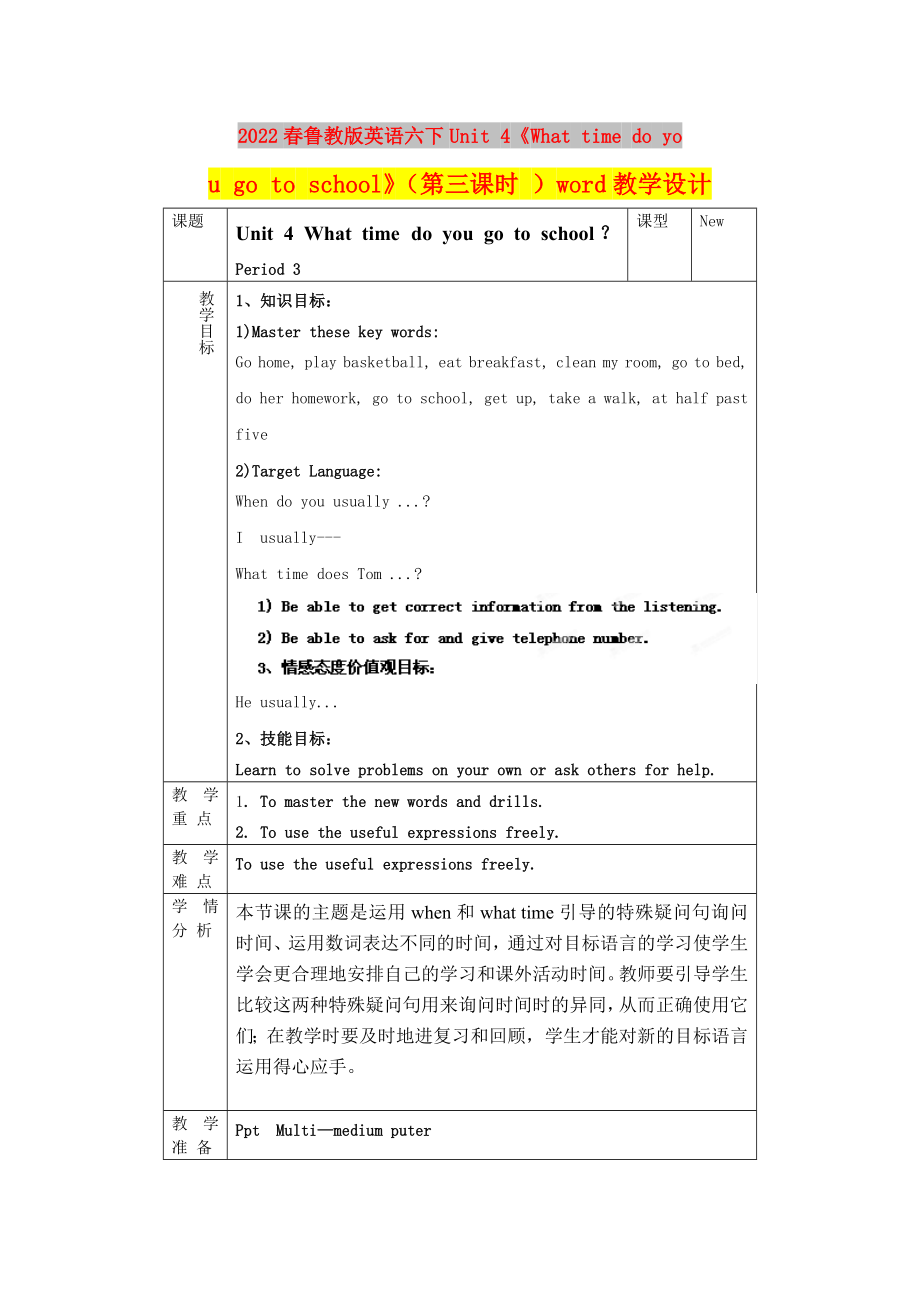《2022春魯教版英語六下Unit 4《What time do you go to school》(第三課時(shí) )word教學(xué)設(shè)計(jì)》由會(huì)員分享���,可在線閱讀���,更多相關(guān)《2022春魯教版英語六下Unit 4《What time do you go to school》(第三課時(shí) )word教學(xué)設(shè)計(jì)(6頁(yè)珍藏版)》請(qǐng)?jiān)谘b配圖網(wǎng)上搜索。
1����、2022春魯教版英語六下Unit 4《What time do yo
u go to school》(第三課時(shí) )word教學(xué)設(shè)計(jì)
課題
Unit 4 What time do you go to school?Period 3
課型
New
教學(xué)目標(biāo)
1��、知識(shí)目標(biāo):
1)Master these key words:
Go home, play basketball, eat breakfast, clean my room, go to bed, do her homework, go to school, get up, take a walk, at half pa
2、st five
2)Target Language:
When do you usually ...?
I usually---
What time does Tom ...?
He usually...
2��、技能目標(biāo):
Learn to solve problems on your own or ask others for help.
教學(xué)重 點(diǎn)
1. To master the new words and drills.
2. To use the useful expressions freely.
教學(xué)難 點(diǎn)
To use the useful exp
3���、ressions freely.
學(xué)情分 析
本節(jié)課的主題是運(yùn)用when和what time引導(dǎo)的特殊疑問句詢問時(shí)間���、運(yùn)用數(shù)詞表達(dá)不同的時(shí)間,通過對(duì)目標(biāo)語言的學(xué)習(xí)使學(xué)生學(xué)會(huì)更合理地安排自己的學(xué)習(xí)和課外活動(dòng)時(shí)間�����。教師要引導(dǎo)學(xué)生比較這兩種特殊疑問句用來詢問時(shí)間時(shí)的異同���,從而正確使用它們����;在教學(xué)時(shí)要及時(shí)地進(jìn)復(fù)習(xí)和回顧����,學(xué)生才能對(duì)新的目標(biāo)語言運(yùn)用得心應(yīng)手。
教學(xué)準(zhǔn) 備
Ppt Multi—medium puter
教學(xué)過程:
個(gè)性學(xué)習(xí)同層展示���、自主學(xué)習(xí)(獨(dú)立學(xué)習(xí)���、小組合作-同質(zhì)合作,異質(zhì)幫扶)����、師生探究、拓展訓(xùn)練��、檢測(cè)反饋/同層展示所學(xué)
集體備課
個(gè)人備課
Step One:
4����、 Show the preview works (exercise books and text books) in layers. (5m)
Teacher: 1. Draw a check table on the blackboard.
2. Watch the students and guide them to do better.
3. Show the aims for students to choose.
(At the same time, students step into the second step slowly, som
5、e by some.)
Step Two: Learn by themselves. (20m)
Students: 1. Choose learning aims.
2. Learn the new content.
1) Learn the new words, try to read and spell them correctly.
2) Read through the conversations in 1c &1e, and try to practice in pairs.
3) Practice the conversations according to 1b
6�、and 1e.
Teacher: Watch the students and help them whenever necessary. Gather questions.
Step Three: Discussion (5m)
Talk about the problems together.
Step Four: Practice: (10m)
Listen and finish the exercises in 1c and 1d.
Step Five: Summary and Test (5m)
Step Six: Show students how to previ
7、ew for next class. (2d-3c)
Homework:
1. Preview 2a and 2b.
2. Do exercises.
3.配套 P26 Ⅵ,Ⅶ(選做)
小結(jié): 學(xué)科知識(shí)構(gòu)建與板書設(shè)計(jì)
Unit 4 What time do you go to school�����?
Learning aims:
1)Master these key words:
Go home, play basketball, eat breakfast, clean my room, go to bed, do her homework, go
8���、 to school, get up, take a walk, at half past five
2)Target Language:
When do you usually ...?
I usually---
What time does Tom ...?
He usually...
反思與重建
附:
課前檢測(cè)題:個(gè)性預(yù)習(xí)作業(yè)同層對(duì)比
課堂檢測(cè)題:Let the students translate:
①你早晨幾點(diǎn)吃早餐�?
_______ ______ do you eat breakfast ______ the morning?
——八點(diǎn)鐘��。— _
9��、____ eight o’clock.
②——足球賽是什么時(shí)候��?
— _____ _____ the football game?
——星期天下午���?���!?_____ Sunday afternoon.
作業(yè)設(shè)置:Homework:
1.Preview 2a and 2b.
2.Do exercises.
3.配套 P26 Ⅵ,Ⅶ(選做)
附送:
2022春魯教版英語六下Unit 4《What time do yo
u go to school》(第二課時(shí))word教學(xué)設(shè)計(jì)
課題
Unit 4 What time do you go to school�? Per
10、iod 2
課型
New
教學(xué)目標(biāo)
1�、知識(shí)目標(biāo):
1)Words:
shower, take, usually, never, morning, night, past, work, best, half, take a shower
2)Target Language:
When does ...?
What time does ...?
He / She takes / eats / gets / goes ..
Help students learn how to ask and answer questions about the shower tim
11、es.
3����、情感態(tài)度價(jià)值觀目標(biāo):
養(yǎng)成良好的作息習(xí)慣,珍惜時(shí)間���,充實(shí)快樂地度過每一天���。
教學(xué)重 點(diǎn)
How to ask and answer questions about the shower times.
教學(xué)難 點(diǎn)
How to ask and answer questions about the shower times.
學(xué)情分 析
本節(jié)課的主題是運(yùn)用when和what time引導(dǎo)的特殊疑問句詢問時(shí)間、運(yùn)用數(shù)詞表達(dá)不同的時(shí)間��,通過對(duì)目標(biāo)語言的學(xué)習(xí)使學(xué)生學(xué)會(huì)更合理地安排自己的學(xué)習(xí)和課外活動(dòng)時(shí)間。對(duì)于when引導(dǎo)的特殊疑問句用來詢問時(shí)間我們已經(jīng)在第一單元學(xué)過�����,教師要引
12�����、導(dǎo)學(xué)生比較這兩種特殊疑問句用來詢問時(shí)間時(shí)的異同���,從而正確使用它們;在表達(dá)不同時(shí)間段時(shí)要運(yùn)用數(shù)詞�,這也是已經(jīng)學(xué)過的內(nèi)容,在教學(xué)時(shí)要及時(shí)地進(jìn)復(fù)習(xí)和回顧��,學(xué)生才能對(duì)新的目標(biāo)語言運(yùn)用得心應(yīng)手�。
教學(xué)準(zhǔn) 備
Ppt Multi—medium puter
教學(xué)過程: 個(gè)性學(xué)習(xí)同層展示、自主學(xué)習(xí)(獨(dú)立學(xué)習(xí)�����、小組合作)����、師生探究、拓展訓(xùn)練、檢測(cè)反饋/同層展示所學(xué)
集體備課
個(gè)人備課
Step One: Show the preview works (text-books and note-paper) in layers. (5m)
Teacher: 1. Draw a check table
13�����、 on the blackboard.
2. Watch the students and guide them to do better.
3. Show the aims for students to choose.
(At the same time, students step into the second step slowly, some by some.)
Step Two: Learn by themselves. (20m)
Students: 1. Choose learning aims.
2. Learn the new
14��、 content.
1) Learn the new words and read and spell them correctly.
2) Role-play the conversations in 2d and try to practice in pairs. Make new conversations.
3) Read and dictate the sentences in Grammar Focus.
Teacher: Watch the students and help them whenever necessary. Gather questions.
Step
15�、 Three: Discussion (5m)
Talk about the problems together.
Step Four: Practice: (10m)
1.3a. write answers or questions using always, usually or never.
2. 3b Write about something you always do, something you usually do and something you never do. Then practice the conversations with your partner
16、.
2.3c plete the chart and practice it with your partner according to it.
Step Five: Summary and Test (5m)
Step Six: Show students how to preview for next class. (3a-3c)
Homework:
3. Preview the new words and read and spell them correctly.
4. Preview the content in 3c.
選做 配套 P25 Ⅳ, VI
小結(jié)
17����、: 學(xué)科知識(shí)構(gòu)建與板書設(shè)計(jì)
Unit 4 What time do you go to school?
1)Words:
shower, take, usually, never, morning, night, past, work, best, half, take a shower
2)Target Language:
When does ...?
What time does ...?
He / She takes / eats / gets / goes ..
反思與重建
附:
課前檢測(cè)題:個(gè)性預(yù)習(xí)作業(yè)同層對(duì)比
課堂檢測(cè)
18�����、題:
用所給單詞的適當(dāng)形式填空��。
1��、She has a shower and ______ (have)her breakfast.
2�����、What time ________ Scott _____ (have)lunch?
3��、He ________ (brush) his teeth every day.
4、The bus usually _______ (take) him to work.
作業(yè)設(shè)置:
Homework:
必做:
1.Preview the new words and read and spell them correctly.
2.Preview the content in 3c.
3. 選做 配套 P25 Ⅳ, VI
 2022春魯教版英語六下Unit 4《What time do you go to school》(第三課時(shí) )word教學(xué)設(shè)計(jì)
2022春魯教版英語六下Unit 4《What time do you go to school》(第三課時(shí) )word教學(xué)設(shè)計(jì)

